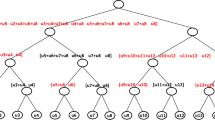Abstract
The order of the channel matrix columns is an important factor that affects the computational complexity, memory requirement, and detection error rate of multi-input multi-output (MIMO) detectors. Novel efficient ordering schemes proposed in our previous work lead to advantages in the computational complexity and memory requirement of various maximum likelihood (ML) MIMO detectors. In this paper, we apply these ordering schemes to the K-Best detector—a near-ML MIMO detector suitable for high-throughput hardware implementations—and show that our novel ordering schemes improve the performance of the K-Best detector, especially when K is small. With a given detection error rate, our ordering schemes either lead to signal-to-noise ratio (SNR) gains, or allow even smaller K. Two of these ordering schemes, which can be easily embedded into the QR decomposition, are implemented in hardware. We adopt Givens based ordering schemes, due to their numerical stability when fixed point representations are used. Our hardware implementation results show that our novel ordering schemes incur negligible overheads and are particularly suitable for high-throughput implementations.











Similar content being viewed by others
References
Kim, K. J., & Iltis, R. A. (2002). Joint detection and channel estimation algorithms for QS-CDMA signals over time-varying channels. IEEE Transactions on communications, 50(5), 845–855.
Lei, Z., Dai, Y., & Sun, S. (2005). A low complexity near ML V-BLAST algorithms. In Proc. IEEE VTC-2005-Fall vehicular technology conference (Vol. 2, pp. 942–946).
Baro, S., Hagenauer, J., & Witzke, M. (2003). Iterative detection of MIMO transmission using a list-sequential (LISS) detector. In Proc. IEEE international conference on communications (Vol. 4, pp. 2653–2657).
Seethaler, D., Artes, H., & Hlawatsch, F. (2006). Dynamic nulling-and-canceling for efficient near-ML decoding of MIMO systems. IEEE Transactions on Signal Processing, 54(12), 4741–4752.
Viterbo, E., & Boutros, J. (1999). A universal lattice code decoder for fading channels. IEEE Transactions on Information Theory, 45(5), 1639–1642.
Damen, O., Chkeif, A., & Belfiore, J.-C. (2000). Lattice code decoder for space-time codes. IEEE Communications Letters, 4(5), 161–163.
Chan, A. M., & Lee, I. (2002). A new reduced-complexity sphere decoder for multiple antenna systems. In Proc. IEEE international conference on communications (Vol. 1, pp. 460–464).
Agrell, E., Eriksson, T., Vardy, A., & Zeger, K. (2002). Closest point search in lattices. IEEE Transactions on Information Theory, 48(8), 2201–2214.
Damen, M. O., El Gamal, H., & Caire, G. (2003). On maximum-likelihood detection and the search for the closest lattice point. IEEE Transactions on Information Theory, 49(10), 2389–2402.
Su, K., & Wassell, I. J. (2005). A new ordering for efficient sphere decoding. In Proc. IEEE international conference on communications (Vol. 3, pp. 1906–1910).
Xu, W., Wang, Y., Zhou, Z., & Wang, J. (2004). A computationally efficient exact ML sphere decoder. In Proc. IEEE global telecommunications conference (Vol. 4, pp. 2594–2598).
Murugan, A. D., El Gamal, H., Damen, M. O., & Caire G. (2006). A unified framework for tree search decoding: Rediscovering the sequential decoder. IEEE Transactions on Information Theory, 52(3), 933–953.
Wong, K., Tsui, C., Cheng, R. S., & Mow, W. (2002). A VLSI architecture of a K-Best lattice decoding algorithm for MIMO channels. In Proc. IEEE international symposium on circuits and systems (Vol. 3, pp. III–273–III–276).
Guo, Z., & Nilsson, P. (2006). Algorithm and implementation of the K-Best sphere decoding for MIMO detection. IEEE Journal on Selected Areas in Communications, 24(3), 491–503.
Dai, Y., & Yan, Z. (2008). Memory-constrained ML-optimal tree search detection. In Proc. 42nd annual conference on information sciences and systems (pp. 1037–1041).
Wolniansky, P. W., Foschini, G. J., Golden, G. D., & Valenzuela, R. A. (1998). V-BLAST: An architecture for realizing very high data rates over the rich-scattering wireless channels. In Proc. URSI international symposium on signals, systems, and electronics (pp. 295–300).
Su, K. (2005). Efficient maximum likelihood detection for communication over multiple input multiple output channels. Ph.D. dissertation, University of Cambridge.
Wubben, D., Bohnke, R., Rinas, J., Kuhn, V., & Kammeyer, K. D. (2001). Efficient algorithm for decoding layered space-time codes. Electronics Letters, 37(22), 1348–1350.
Wiesel, A., Mestre, X., Pages, A., & Fonollosa, J. R. (2003). Efficient implementation of sphere demodulation. In Proc. 4th IEEE workshop on signal processing advances in wireless communications (pp. 36–40).
Burg, A., Borgmann, M., Wenk, M., Zellweger, M., Fichtner, W., & Bolcskei, H. (2005). VLSI implementation of MIMO detection using the sphere decoding algorithms. IEEE Journal of Solid-State Circuits, 40(7), 1566–1577.
Huang, X., Liang, C., & Ma, J. (2008). System architecture and implementation of MIMO sphere decoders on FPGA. IEEE Transactions on Very Large Scale Integration (VLSI) Systems, 16(2), 188–197.
Dai, Y., & Yan, Z. (2008). Efficient ordering schemes for sphere decoder. In Proc. IEEE workshop on signal processing systems (pp. 146–151).
Dai, Y., & Yan, Z. (2009). Memory-constrained tree search detection and new ordering schemes. IEEE Journal of selected topics in signal processing (Vol. 3, no. 6, pp. 1026–1037).
Luethi, P., Studer, C., Duetsch, S., Zgraggen, E., Kaeslin, H., Felber, N., et al. (2008). Gram–Schmidt-based QR decomposition for MIMO detection: VLSI implementation and comparison. In Proc. IEEE Asia Pacific conference on circuits and systems (pp. 830–833).
Knagge, G., Bickerstaff, M., Ninness, B., Weller, S. R., & Woodward, G. (2006). A VLSI 8 × 8 MIMO near-ML decoder engine. In Proc. IEEE workshop on signal processing systems design and implementation (pp. 387–392).
Luethi, P., Burg, A., Haene, S., Perels, D., Felber, N., & Fichtner, W. (2007). VLSI implementation of a high-speed iterative sorted MMSE QR decomposition. In Proc. IEEE international symposium on circuits and systems (pp. 1421–1424).
Golub, G. H., & Van Loan, C. F. (1996). Matrix computations. Baltimore, MD: Johns Hopkins University Press.
Volder, J. E. (1959) The CORDIC trigonometric computing technique. IEEE Transactions on Electronic Computers, EC-8(3), 330–334.
Meher, P. K., Valls, J., Juang, T.-B., Sridharan, K., & Maharatna, K. (2009). 50 years of CORDIC: Algorithms, architectures, and applications. IEEE Transactions on Circuits and Systems, 56(9), 1893–1907.
IEEE 802.11n-2009, Amendment 5: Enhancements for higher throughput (2009). IEEE Std.
Available online. http://vcag.ecen.okstate.edu/.
Available online. http://www.ist-mascot.org/.
Acknowledgements
This work was financed in part by a grant from the Commonwealth of Pennsylvania, Department of Community and Economic Development, through the Pennsylvania Infrastructure Technology Alliance (PITA), and in part by Thales Communications Inc. The authors would like to acknowledge the Integrated Systems Laboratory at Swiss Federal Institute of Technology Zurich for their sharing of the MIMO system reference designs.
Author information
Authors and Affiliations
Corresponding author
Rights and permissions
About this article
Cite this article
Wu, X., Dai, Y., Wang, Y. et al. Efficient Ordering Schemes for High-Throughput MIMO Detectors. J Sign Process Syst 64, 61–74 (2011). https://doi.org/10.1007/s11265-010-0486-5
Received:
Revised:
Accepted:
Published:
Issue Date:
DOI: https://doi.org/10.1007/s11265-010-0486-5




